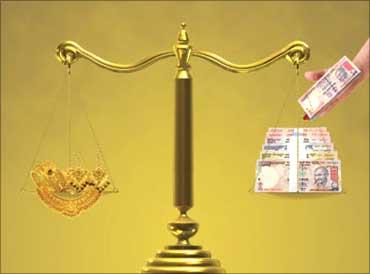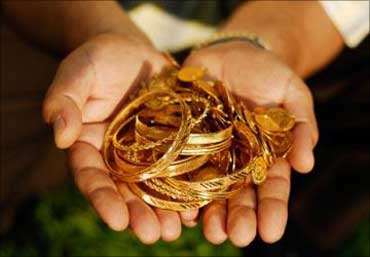Photographs: Rediff Archives Vaibhav Aggarwal, RupeeTimes.com
Here's how banks charge interest rate and decide on the amount to loan when you go for gold financing.
Gold has always been considered one of the prime assets in India because of its monetary value, its association with the goddess of wealth Lakshmi, and also because of the emotional value one associates with the noble metal. The importance of gold can be valued from the fact that it is one of the most important heritages alongside land which is passed over from one generation to another.
With increasing disposable incomes, and more liberal outlook towards lifestyle, gold-based financing has picked up pace in the last decade. People are now willing to keep their gold as collateral with lenders, considered a taboo once. Although major banks like HDFC Bank, ICICI Bank offer loans against gold as collateral, it is lenders like Manappuram and Muthoot who have specialised in the field and gained popularity with those seeking funds.
Courtesy:
Read THIS before you go for gold loans!
Photographs: Rediff Archives
Gold loans or loans against gold
Gold loans can be differentiated from personal loans in the way that gold loans are backed by a security and consume lesser paper work, against personal loans which do not have any collateral and require more paperwork.
Gold loans also offer a higher loan to value (LTV) compared to personal loans, which means lesser margin from the borrower's end.
Loan to value ratio = Mortgage amount/Appraised value fo the property
Read THIS before you go for gold loans!
Photographs: Rediff Archives
There are various financial entities that offer varying combinations of LTV and interest rates. These two are dependent directly upon each other. This means higher contribution from the borrower results into lesser interest rate.
As per RBI regulations, the lower limit for LTV is 60 per cent for NBFCs, which indicates that the loan principal should be at least 60 per cent of the value of the asset.
Interest payments also depend on LTV; higher LTV require a borrower to pay interests at a regular intervals. These loans are generally of duration of one year or less.
Read THIS before you go for gold loans!
Photographs: Rediff Archives
The base rate for the NBFCs tendering loans against gold is pegged at 12 per cent, higher than that offered by commercial banks (10 per cent).
The loans offered by these non-banking finance companies are at least 3 to 12 per cent above the base rate. While in case of banks, the interest rate offered is lower because of tighter regulations and more rigorous credit checking of the borrower.
Another difference between these two entities is that banks levy extra charges like pre-payment penalty in case you close the loan before its original tenure.
Read THIS before you go for gold loans!
Photographs: Rediff Archives
Loan to buy gold
Another relatively newer aspect of gold financing is availing loan to purchase gold. The amount of this loan could be as little as Rs 1,000 and go upto Rs 15 lakh (Rs 1.5 million). This scheme is mainly targetted at working women who need to buy gold, but do not have sufficient cash to do so.
The bank and NBFCs offer loans of up to 10 times the salary of the borrower at interest rates around 3 to 3.5 per cent above the base rate. The longer the tenure of the loan, the higher the interest rates charged on the loan. The installments for such loans are generally paid in multiples of 12 months, up to a maximum of 60 EMIs.
Read THIS before you go for gold loans!
Photographs: Rediff Archives
Under the loan-to-buy-gold scheme, the borrower makes a down payment of a certain amount as per requirements set by the product and the merchant. For instance under Manappuram loan for gold scheme, a customer has to pay 25 per cent of the total amount to the jeweller in case s/he needs an ornament; 15 per cent to an outside vendor in case of buying gold coins; and 5 per cent of total amount if s/he buys gold coins from Manappuram.
After the first downpayment, the borrower pays EMIs to the lender, which in turn credits the amount to the jeweller's account. The borrower can only take the physical possession of the ornament or coin, only when s/he has repaid the entire loan. More specifications about the loans could be found on the web sites of the banks and NBFCs.







Comment
article